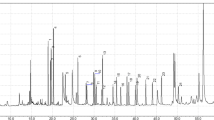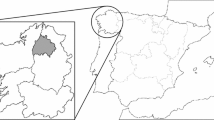Abstract
Halogenated organic pollutants (HOPs)—including organochlorine pesticides (OCPs), polychlorinated biphenyls (PCBs), polybrominated diphenylethers (PBDEs), polybromobiphenyls (PBBs), dechlorane plus (DP), tetrabromobisphenol A (TBBPA), and hexabromocyclododecanes (HBCDs) as well as PCB metabolites (methylsulfone [MeSO2-]) and hydroxylated (OH-) PCBs and OH-PBDEs—were determined in the serum of mud carp and northern snakehead from an electronic-waste (e-waste) site in South China. The average concentrations (mean ± SD) of ΣPCBs, ΣPBDEs, ΣOCPs, ΣPBBs, ΣTBBPA, ΣHBCDs, and ΣDP were 1410 ± 324, 70 ± 20, 3.0 ± 0.4, 2.8 ± 0.8, 1.6 ± 0.4, 1.0 ± 0.2, and 0.3 ± 0.03 ng/g wet weight (ww) in mud carp and 6430 ± 781, 468 ± 49, 22.4 ± 1.1, 7.0 ± 0.6, 2.9 ± 2.3, 5.5 ± 1.1, and 4.6 ± 0.6 ng/g ww in northern snakehead, respectively. MeSO2-PCBs, OH-PCBs, and OH-PBDEs were detected at a total concentration of 0.44 ± 0.03 and 9.7 ± 0.3 ng/g ww in mud carp and northern snakehead, respectively. The congener profiles of PCBs, PBDEs, OH/MeSO2-PCBs, and OH-PBDEs were found to be significantly different between the two fish species, possibly as a result of species-specific bioaccumulation and/or metabolism of the HOPs. Chirality of ten PCB congeners and α-HBCD, as well as the f anti values of DP in the serum samples, supported the species-specific biotransformation of HOPs. Furthermore, the presence of covaried and counter-varied enantiomeric fractions of PCBs between the two fish species indicated species- and congener-specific enantiomer enrichment of PCBs.



Similar content being viewed by others
References
Betts KS (2008) New thinking on flame retardants. Environ Health Perspect 116:A210
Buckman AH, Wong CS, Chow EA, Brown SB, Solomon KR, Fisk AT (2006) Biotransformation of polychlorinated biphenyls (PCBs) and bioformation of hydroxylated PCBs in fish. Aquat Toxicol 78:176–185
Bussolaro D, Filipak Neto F, Glinski A, Roche H, Guiloski IC, Mela M et al (2012) Bioaccumulation and related effects of PCBs and organochlorinated pesticides in freshwater fish Hypostomus commersoni. J Environ Monit 14:2154–2163
Campbell LM, Muir DC, Whittle DM, Backus S, Norstrom RJ, Fisk AT (2003) Hydroxylated PCBs and other chlorinated phenolic compounds in lake trout (Salvelinus namaycush) blood plasma from the Great Lakes region. Environ Sci Technol 37:1720–1725
De la Torre A, Pacepavicius G, Martínez M, Darling C, Muir D, Sherry J et al (2013) Polybrominated diphenyl ethers and their methoxylated and hydroxylated analogs in brown bullhead (Ameiurus nebulosus) plasma from Lake Ontario. Chemosphere 90:1644–1651
Feng AH, Chen SJ, Chen MY, He MJ, Luo XJ, Mai BX (2012) Hexabromocyclododecane (HBCD) and tetrabromobisphenol A (TBBPA) in riverine and estuarine sediments of the Pearl River Delta in southern China, with emphasis on spatial variability in diastereoisomer-and enantiomer-specific distribution of HBCD. Mar Pollut Bull 64:919–925
Gao F, Luo X-J, Yang Z-F, Wang X-M, Mai B-X (2009) Brominated flame retardants, polychlorinated biphenyls, and organochlorine pesticides in bird eggs from the Yellow River Delta, North China. Environ Sci Technol 43:6956–6962
Gebbink WA, Sonne C, Dietz R, Kirkegaard M, Riget FF, Born EW et al (2008) Tissue-specific congener composition of organohalogen and metabolite contaminants in east Greenland polar bears (Ursus maritimus). Environ Pollut 152:621–629
Guan YF, Wang JZ, Ni HG, Zeng EY (2009) Organochlorine pesticides and polychlorinated biphenyls in riverine runoff of the Pearl River Delta, China: assessment of mass loading, input source and environmental fate. Environ Pollut 157:618–624
Guo LL, Qiu YW, Zhang G, Zheng GJ, Lam PKS, Li XD (2008a) Levels and bioaccumulation of organochlorine pesticides (OCPs) and polybrominated diphenyl ethers (PBDEs) in fishes from the Pearl River estuary and Daya Bay, South China. Environ Pollut 152:604–611
Guo Y, Meng XZ, Tang HL, Zeng EY (2008b) Tissue distribution of organochlorine pesticides in fish collected from the Pearl River Delta, China: Implications for fishery input source and bioaccumulation. Environ Pollut 155:150–156
Haraguchi K, Kuroki H, Masuda Y (1989) Occurrence and distribution of chlorinated aromatic methylsulfones and sulfoxides in biological samples. Chemosphere 19:487–492
Hoh E, Zhu LY, Hites RA (2006) Dechlorane plus, a chlorinated flame retardant, in the Great Lakes. Environ Sci Technol 40:1184–1189
Karlsson H, Muir DC, Teixiera CF, Burniston DA, Strachan WM, Hecky RE et al (2000) Persistent chlorinated pesticides in air, water, and precipitation from the Lake Malawi area, southern Africa. Environ Sci Technol 34:4490–4495
Kefeni KK, Okonkwo JO, Olukunle OI, Botha BM (2011) Brominated flame retardants: sources, distribution, exposure pathways, and toxicity. Environ Rev 19:238–253
Kierkegaard A, Burreau S, Marsh G, Klasson-Wehler E, de Wit C, Asplund L (2001) Metabolism and distribution of 2,2’, 4,4’-tetrabromo [14C] diphenyl ether in pike (Esox lucius) after dietary exposure. Organohalog Compd 52:58–61
Lehmler HJ, Harrad SJ, Hühnerfuss H, Kania-Korwel I, Lee CM, Lu Z et al (2010) Chiral polychlorinated biphenyl transport, metabolism, and distribution: a review. Environ Sci Technol 44:2757–2766
Letcher RJ, Klasson-Wehler E, Bergman Å (2000) Methyl sulfone and hydroxylated metabolites of polychlorinated biphenyls. Handb Environ Chem 3:315–359
Li HX, Drouillard KG, Bennett E, Douglas Haffner G, Letcher RJ (2003) Plasma-associated halogenated phenolic contaminants in benthic and pelagic fish species from the Detroit River. Environ Sci Technol 37:832–839
Luo XJ, Zhang XL, Liu J, Wu JP, Luo Y, Chen SJ et al (2008) Persistent halogenated compounds in waterbirds from an e-waste recycling region in South China. Environ Sci Technol 43:306–311
Lyche JL, Grzes IM, Karlsson C, Nourizadeh-Lillabadi R, Berg V, Kristoffersen AB et al (2013) Parental exposure to natural mixtures of POPs reduced embryo production and altered gene transcription in zebrafish embryos. Aquat Toxicol 126:42–434
Morris S, Allchin CR, Zegers BN, Haftka JJH, Boon JP, Belpaire C et al (2004) Distribution and fate of HBCD and TBBPA brominated flame retardants in North Sea estuaries and aquatic food webs. Environ Sci Technol 38:5497–5504
Peng H, Zhang K, Wan Y, Hu J (2012) Tissue distribution, maternal transfer, and age-related accumulation of dechloranes in Chinese sturgeon. Environ Sci Technol 46:9907–9913
Russell RW, Gobas FA, Douglas Haffner G (1999) Role of chemical and ecological factors in trophic transfer of organic chemicals in aquatic food webs. Environ Toxicol Chem 18:1250–1257
Sandala GM, Sonne-Hansen C, Dietz R, Muir D, Valters K, Bennett E et al (2004) Hydroxylated and methyl sulfone PCB metabolites in adipose and whole blood of polar bear (Ursus maritimus) from East Greenland. Sci Total Environ 331:125–141
Stapleton HM, Letcher R, Baker J (2001) Metabolism of PCBs by the deepwater sculpin (Myoxocephalus thompsoni). Environ Sci Technol 35:4747–4752
Tomy GT, Pleskach K, Ismail N, Whittle DM, Helm PA, Sverko E et al (2007) Isomers of dechlorane plus in Lake Winnipeg and Lake Ontario food webs. Environ Sci Technol 41:2249–2254
Towerzey L, Bowden BF, Junk PC (2000) A new brominated diphenyl ether from the marine sponge Dysidea herbacea. Aust J Chem 53:299–301
Valters K, Li HX, Alaee M, D’Sa I, Marsh G, Bergman Å et al (2005) Polybrominated diphenyl ethers and hydroxylated and methoxylated brominated and chlorinated analogues in the plasma of fish from the Detroit River. Environ Sci Technol 39:5612–5619
Verreault J, Letcher RJ, Muir DC, Chu S, Gebbink WA, Gabrielsen GW (2005) New organochlorine contaminants and metabolites in plasma and eggs of glaucous gulls (Larus hyperboreus) from the Norwegian Arctic. Environ Toxicol Chem 24:2486–2499
Weijs L, Das K, Siebert U, Van Elk N, Jauniaux T, Neels H et al (2009a) Concentrations of chlorinated and brominated contaminants and their metabolites in serum of harbour seals and harbour porpoises. Environ Int 35:842–850
Weijs L, Losada S, Das K, Roosens L, Reijnders PJH, Santos JF et al (2009b) Biomagnification of naturally-produced methoxylated polybrominated diphenyl ethers (MeO-PBDEs) in harbour seals and harbour porpoises from the Southern North Sea. Environ Int 35:893–899
Wiseman SB, Wan Y, Chang H, Zhang X, Hecker M, Jones PD et al (2011) Polybrominated diphenyl ethers and their hydroxylated/methoxylated analogs: environmental sources, metabolic relationships, and relative toxicities. Mar Pollut Bull 63:179–188
Wu JP, Guan YT, Zhang Y, Luo XJ, Zhi H, Chen SJ et al (2010a) Trophodynamics of hexabromocyclododecanes and several other non-PBDE brominated flame retardants in a freshwater food web. Environ Sci Technol 44:5490–5495
Wu JP, Zhang Y, Luo XJ, Wang J, Chen SJ, Guan YT et al (2010b) Isomer-specific bioaccumulation and trophic transfer of dechlorane plus in the freshwater food web from a highly contaminated site, south china. Environ Sci Technol 44:606–611
Xian Q, Siddique S, Li T, Feng Y-l, Takser L, Zhu J (2011) Sources and environmental behavior of dechlorane plus—a review. Environ Int 37:1273–1284
Zeng YH, Yu LH, Luo XJ, Chen SJ, Wu JP, Mai BX (2013) Tissue accumulation and species-specific metabolism of technical pentabrominated diphenyl ether (DE-71) in two predator fish. Environ Toxicol Chem 32:757–763
Zeng YH, Luo XJ, Tang B, Zheng XB, Mai BX (2014) Gastrointestinal absorption, dynamic tissue-specific accumulation, and isomer composition of dechlorane plus and related analogs in common carp by dietary exposure. Ecotoxicol Environ Safe 100:32–38
Zhang G, Li X, Mai B, Peng Pa, Ran Y, Wang X et al (2007) Sources and occurrence of persistent organic pollutants in the Pearl River Delta, South China. Dev Environ Sci 7:289–311
Zhang K, Schnoor JL, Zeng EY (2012a) E-waste recycling—where does it go from here? Environ Sci Technol 46:10861–10867
Zhang Y, Wu JP, Luo XJ, She YZ, Mo L, Mai BX (2012b) Methylsulfonyl polychlorinated biphenyls in fish from an electronic waste-recycling site in South China: levels, congener profiles, and chiral signatures. Environ Toxicol Chem 31:2507–2512
Zhu LY, Hites RA (2004) Temporal trends and spatial distributions of brominated flame retardants in archived fishes from the Great Lakes. Environ Sci Technol 38:2779–2784
Acknowledgments
This work was supported financially by the Ministry of Environmental protection of the China (Grant No. 201309030-02), the Chinese Academy of Sciences (Grant No. KZCX-EW-QN105), and the National Nature Science Foundation of China (Grants No. 41273118 and 41230639). This is contribution No. IS-1904 from GIGCAS.
Author information
Authors and Affiliations
Corresponding author
Electronic supplementary material
Below is the link to the electronic supplementary material.
Rights and permissions
About this article
Cite this article
Zeng, YH., Luo, XJ., Zheng, XB. et al. Species-Specific Bioaccumulation of Halogenated Organic Pollutants and Their Metabolites in Fish Serum from an E-Waste Site, South China. Arch Environ Contam Toxicol 67, 348–357 (2014). https://doi.org/10.1007/s00244-014-0040-8
Received:
Accepted:
Published:
Issue Date:
DOI: https://doi.org/10.1007/s00244-014-0040-8




